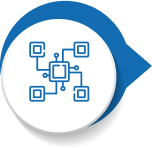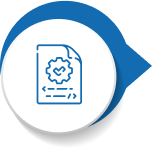
EDI (Electronic Data Interchange) is the method of exchanging business documents between companies in a standardized digital format. It replaces the use of paper, making the transfer of data quicker, more precise, and efficient. With EDI, businesses can send documents like purchase orders, invoices, and shipping notices automatically, without needing manual input.
How Does EDI Work?
EDI works by enabling electronic communication between trading partners, using standardized formats that are automatically read and processed by systems. Here are the basic steps of how EDI works:
Document Creation
The process begins when a business creates an electronic document, such as a purchase order, invoice, or shipment notification. Instead of using paper documents, the business uses an EDI software system to create a digital version of the document. This digital document contains all the necessary details for the transaction.
Data Translation
Once the document is created, it needs to be converted into a format that can be read by the recipient’s system. This is where EDI mapping and translation software comes in. The document is transformed into a standardized EDI format, such as X12 or EDIFACT, which ensures that it can be understood by any EDI system, regardless of the company’s internal systems or software.
Transmission
After the document is translated, it is transmitted to the receiving system. This is done over a secure network to ensure that sensitive data is protected during transmission. The network may be an EDI VAN (Value-Added Network) or directly over the internet using secure protocols like AS2.
Processing
The receiving system then reads the EDI document, interpreting the data and updating its records accordingly. For example, if the document is a purchase order, the recipient’s system might automatically update inventory levels, generate an invoice, or prepare a shipment. The system processes the document automatically, without requiring manual data entry.
Acknowledgment
Once the recipient’s system processes the document, an acknowledgment is sent back to the sender. This acknowledgment confirms that the document was successfully received and processed. It helps ensure that both parties are aligned and that no information is lost or overlooked during the exchange.
Common EDI Standards
EDI standards outline the formats and protocols required to ensure business documents can be exchanged and understood across different systems. These standards promote compatibility between organizations, simplifying the automation of processes across industries.
 widely used standard in North America for electronic business transactions, including invoicing, purchasing, and shipping documents. ANSI X12 ensures that data is transferred correctly between different computer systems, helping businesses automate and simplify their processes.
widely used standard in North America for electronic business transactions, including invoicing, purchasing, and shipping documents. ANSI X12 ensures that data is transferred correctly between different computer systems, helping businesses automate and simplify their processes.
 (Electronic Data Interchange for Administration, Commerce, and Transport) is an international EDI standard, mainly used in Europe and other regions, designed to handle a wide range of business transactions. It helps businesses in different countries and industries communicate and process data more efficiently.
(Electronic Data Interchange for Administration, Commerce, and Transport) is an international EDI standard, mainly used in Europe and other regions, designed to handle a wide range of business transactions. It helps businesses in different countries and industries communicate and process data more efficiently.
 an EDI standard used primarily in the UK, particularly in the retail and grocery sectors. It defines formats for exchanging documents like orders, invoices, and shipment details. It was created to help companies automate transactions and improve communication between retailers, suppliers, and distributors.
an EDI standard used primarily in the UK, particularly in the retail and grocery sectors. It defines formats for exchanging documents like orders, invoices, and shipment details. It was created to help companies automate transactions and improve communication between retailers, suppliers, and distributors.
 is a method of exchanging business data using XML (eXtensible Markup Language) for EDI (Electronic Data Interchange). It commonly used for exchanging documents like orders, invoices, and shipping information, and is widely adopted for web-based and internet communications.
is a method of exchanging business data using XML (eXtensible Markup Language) for EDI (Electronic Data Interchange). It commonly used for exchanging documents like orders, invoices, and shipping information, and is widely adopted for web-based and internet communications.
 (Verband der Automobilindustrie) is a German standard primarily used in the automotive industry for exchanging order and delivery schedules between car manufacturers, suppliers, and logistics companies.
(Verband der Automobilindustrie) is a German standard primarily used in the automotive industry for exchanging order and delivery schedules between car manufacturers, suppliers, and logistics companies.
 (Health Insurance Portability and Accountability Act) is a U.S. law that sets standards for the protection and privacy of patient health information. It ensures that sensitive medical data is securely transmitted and shared, particularly in the healthcare industry.
(Health Insurance Portability and Accountability Act) is a U.S. law that sets standards for the protection and privacy of patient health information. It ensures that sensitive medical data is securely transmitted and shared, particularly in the healthcare industry.
 is a set of global standards for EDI used primarily in the high-tech and electronics industries. It defines protocols for exchanging business documents like orders, invoices, and inventory data between companies.
is a set of global standards for EDI used primarily in the high-tech and electronics industries. It defines protocols for exchanging business documents like orders, invoices, and inventory data between companies.
 (Organization for Data Exchange by Tele Transmission in Europe) is a set of standards for EDI used primarily in the automotive industry, particularly in Europe. It defines formats for exchanging key documents in the automotive supply chain, improving communication and efficiency.
(Organization for Data Exchange by Tele Transmission in Europe) is a set of standards for EDI used primarily in the automotive industry, particularly in Europe. It defines formats for exchanging key documents in the automotive supply chain, improving communication and efficiency.
Industries That Use EDI
Retail and E-Commerce
EDI is crucial in retail for managing orders, inventory, and payments. Retailers and online stores use EDI to process orders faster, keep track of stock more accurately, and build stronger relationships with suppliers. It helps everything run smoothly and quickly, reducing manual work and errors.
Manufacturing and Supply Chain
Manufacturers rely on EDI to communicate with suppliers, manage raw material orders, and oversee production schedules. It enables them to collaborate with multiple suppliers and partners in real-time.
Healthcare and Pharmaceuticals
EDI is widely used in healthcare for exchanging patient information, insurance claims, and prescriptions. It helps healthcare providers, insurance companies, and pharmacies ensure accurate, quick processing of claims and prescriptions.
Logistics and
Transportation
Logistics companies use EDI to simplify communication with carriers and shippers. It helps streamline scheduling, shipment tracking, and billing, enhancing the efficiency of supply chain management.
Automotive Industry
In the automotive industry, EDI facilitates communication between manufacturers, suppliers, and dealers. It automates processes like parts ordering, inventory management, and shipment tracking.
Banking and Finance
Financial institutions use EDI to securely transmit transaction data, such as wire transfers, payment instructions, and account information, reducing the risk of errors.
Energy and Utilities
Energy companies rely on EDI to manage billing, meter readings, and supply chain data. It enhances communication between energy suppliers, distributors, and consumers, making operations more transparent and efficient.
Benefits of Electronic Data Interchange

Reduce Errors
EDI automates data exchange, greatly minimizing the errors that typically happen with manual entry. This results in more precise and dependable transactions.

Increase Security
EDI provides a more secure way to transmit sensitive information. Since the data is exchanged through encrypted channels, it reduces the chances of data breaches or unauthorized access.

Improves Traceability
EDI automates data exchange, greatly minimizing the errors that typically happen with manual entry. This results in more precise and dependable transactions.

Better Business Relations
EDI enables faster and more accurate communication with suppliers and customers. This improves relationships by ensuring that all parties are on the same page and that transactions are processed smoothly.

Scalability and Flexibility
As businesses grow, EDI systems can easily scale to handle increasing transaction volumes and additional partners. EDI solutions are flexible, allowing companies to adapt as their needs change.

Competitive Advantage Over Other Firms
Using EDI helps companies streamline operations, reduce costs, and enhance customer service, providing a competitive edge over firms that rely on manual processes or slower communication methods.
Challenges in Implementing EDI

High Initial Setup Costs
Setting up an EDI system can involve significant upfront costs for software, training, and infrastructure. This can be a barrier for small businesses.

Complex Integration with Legacy Systems
Integrating EDI with existing legacy systems can be complex and time-consuming. It may require custom solutions to ensure compatibility.

Lack of Standardization Across Industries
Not all industries or businesses use the same EDI standards, leading to compatibility issues. This can make it harder to collaborate with partners who use different formats.

Training and Skill Gaps
Employees need to be trained to use EDI systems effectively. Businesses may face challenges in finding skilled personnel or dedicating time to training staff.

Security and Compliance Concerns
EDI involves the exchange of sensitive business data, which makes security a significant concern. Compliance with regulations (e.g., HIPAA for healthcare) also requires additional attention.

Dependence on Trading Partner Adoption
EDI’s effectiveness depends on trading partners adopting the same system. If partners are unwilling or unable to integrate EDI, it can hinder smooth operations.

Scalability Issues with Growing Business Needs
As businesses grow and add more partners, scaling EDI solutions to handle increased transactions can become difficult and costly.
How Can iTech Support Your Electronic Data Interchange Requirements?
iTech offers an easy-to-use EDI solution that helps businesses simplify data exchange, reduce costs, and increase efficiency. Our platform works with different EDI standards, making it easy to connect with your partners. We also help integrate EDI into your existing system, offering flexible solutions that grow with your business. With our managed EDI services, we ensure secure and reliable data transfers, so you can focus on your business while we take care of the technical side.
Streamline your operations with iTech’s EDI solutions! Reach out today for a tailored approach to your business needs.







